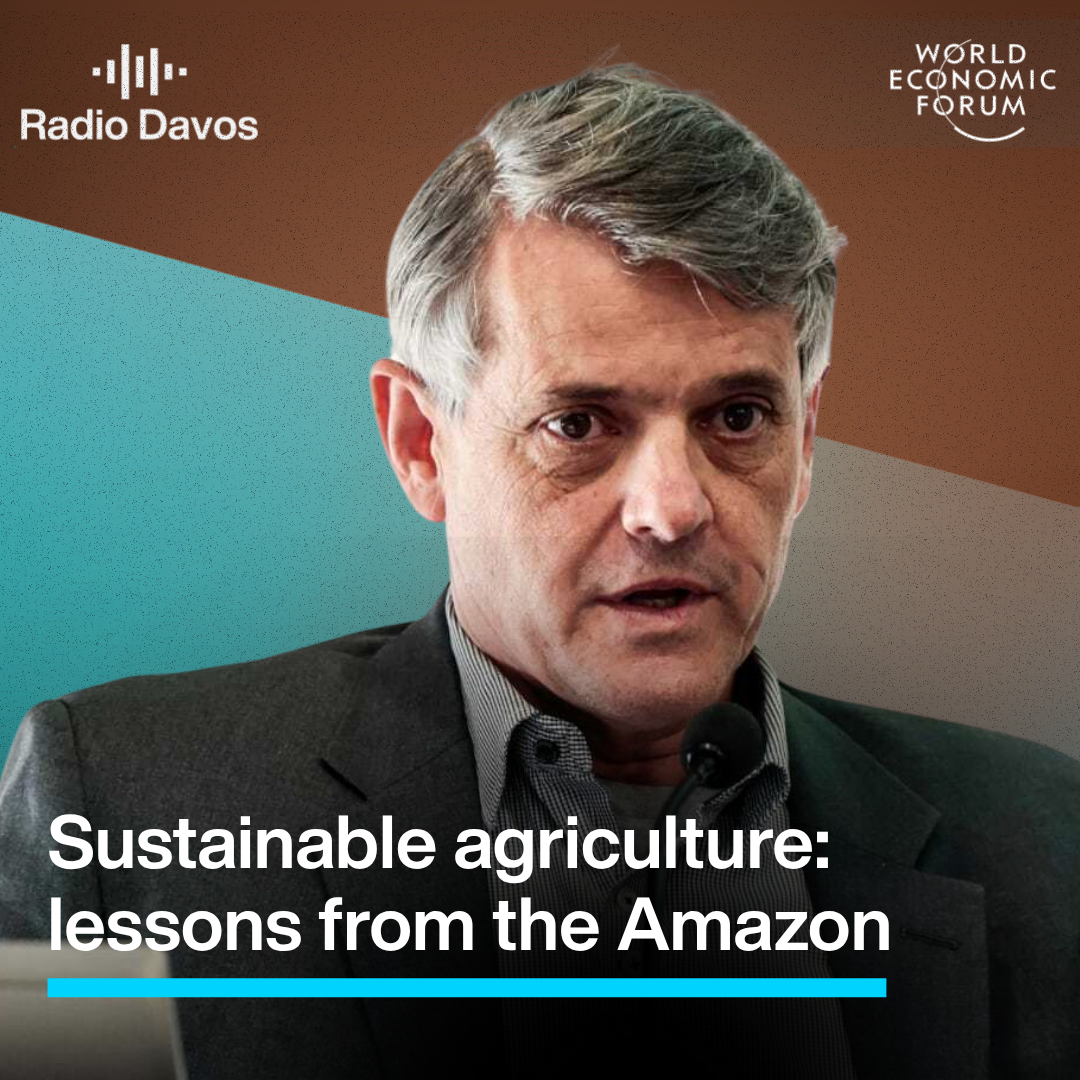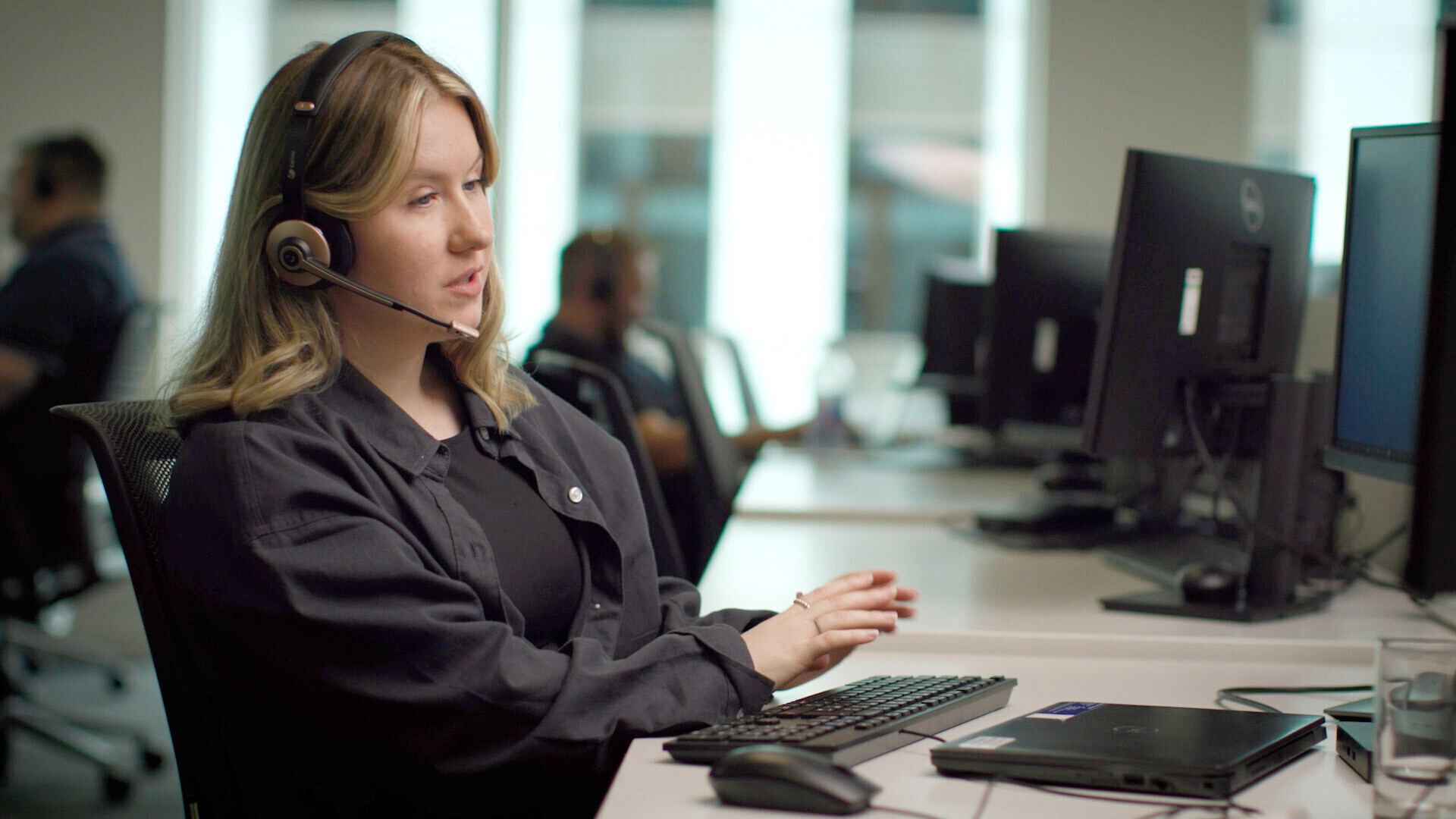What 20 years of Second Life can teach us about the future of the metaverse
Scroll down for full podcast transcript.
In 2003 - the a year before a 19-year-old Harvard student called Mark Zuckerberg created Facebook - Philip Rosedale launched Second Life - an online virtual world that looked set to transform the internet.
Two decades later, with the Facebook company, now called Meta, and its competitors seeking to develop the metaverse, what does Rosedale see as the future of the still emerging technology?
Interview by Linda Lacina, host of the weekly Meet the Leader podcast.
Related episodes:
Check out all our podcasts on wef.ch/podcasts:
Join the World Economic Forum Podcast Club
播客文字稿
This transcript has been generated using speech recognition software and may contain errors. Please check its accuracy against the audio.
Philip Rosedale: It sort of is this city, if you will, of a million people that has just kind of been there for the last couple of decades in an entirely virtual place.
Robin Pomeroy: Welcome to Radio Davos, the podcast from the World Economic Forum that looks at the biggest challenges and how we might solve them. This week: the metaverse - that virtual world that many people see as the future of the internet - it's been around to some extent for longer than you might think.
Philip Rosedale: I started the company in 1999 and Second Life launched in 2003. Today it's it's more than 20 years old, which is amazing
Robin Pomeroy: Back then Second Life was the next big thing. Its founder tells us about its origins.
Philip Rosedale: Second Life is a virtual world. It was designed before the time of the VR devices. And so it's a virtual world on a screen. But it's a world where, unlike a video game, you can pretty much do anything you want. People that choose to live there and work there can do so.
Robin Pomeroy: The man who founded Second Life tells us about the biggest challenges facing the companies creating today’s metaverse.
Philip Rosedale: The biggest thing that is going to make metaverses finally begin to have global impact, is going to be the true sense of other people there in a way that is satisfying to most of us.
Robin Pomeroy: Subscribe to Radio Davos wherever you get your podcasts, or visit wef.ch/podcasts where you will also find Meet the Leader, Agenda Dialogues and the World Economic Forum Book Club Podcast.
I’m Robin Pomeroy at the World Economic Forum, and with the founder of Second Life on the future of the metaverse...
Philip Rosedale: We have to graduate from these initial experiments that look a lot like video games, to some kind of a general purpose architecture that is open and safe in such a way that we would be sane to go there.
Robin Pomeroy: This is Radio Davos.
Two years ago, the Facebook company rebranded itself as Meta - signaling the importance of the metaverse, which it said, and I quote from its press release: The metaverse “will let you share immersive experiences with other people even when you can’t be together — and do things together you couldn’t do in the physical world.”
That was two years ago - now think back 20 years - in 2003 - this is the year before the original Facebook was created by 19-year-old Harvard student Mark Zuckerberg - in 2003 a virtual world was created and it was called Second Life.
The first time I heard of Second Life was a couple of years later when the company that I worked for at the time, the news agency Reuters, put an actual news correspondent into that virtual world to report back to the real world on what was going on in there. That’s a full-time Reuters correspondent inside a virtual world, a couple of decades ago. Around 2006, when this was happening, people were talking about Second Life as the Next Big Thing, and Reuters clearly thought it was worth paying for a full-time correspondent there.
The hype gradually faded, but Second Life does still exist - it has thousands of active members and its founder, Philip Rosedale, has recently returned to the company as a strategic advisor.
We wanted to talk to him to get an idea of what happened at Second Life, what’s needed to make virtual spaces truly capture imaginations, and what the person who created it two decades ago sees as the future of today’s metaverse.
My New York-based colleague Linda Lacina interviewed Philip Rosedale and started by asking him to explain - what is Second Life.
Philip Rosedale: So Second Life, for those who have never seen it before, is a virtual world.
It was designed before the time of the VR devices. And so it's a virtual world on a screen. But it's a world where, unlike a video game, you can pretty much do anything you want. And going along with that world, there's a whole economic system inside it so that the people that choose to live there and work there can do so.
So it is very much another world and it's designed to have all the visual detail and the, you know, qualities and the feel of being in the real world as much as is possible.
Linda Lacina: Why did you found Second Life? What was behind that, was that 'aha' moment?
Philip Rosedale: Well, I started Second Life for a number of reasons.
As a kid, I learned to program computers and I was also interested in physics, which I later studied in college. And I became really interested by the question of whether the real world could be simulated on a computer in such a way that you could make, by putting together, connecting together a large number of computers, you could create a virtual world that was big enough and interesting enough in the way that it worked so that people could make amazing things there and that, you know, just going there and wandering around would be marvellous and awe inspiring.
And so from the time I was pretty young until the time that entrepreneurially I continued to learn about technology and work on things related to technology, there came a point where I realised, I think I can finally do this now and, and that's what I did.
Linda Lacina: And that was a good 20 years ago. The internet was in a different place, a different lifecycle back then. How is the second life different? How was it different back then? Give us a description.
Philip Rosedale: Well, Second Life, I started the company in 1999 and Second Life launched in 2003. And now today it's more than 20 years old, which is amazing and inspiring.
Second Life was different back then in that computers were tremendously slower than they are today. The graphics weren't as good.
But what's been kind of interesting about Second Life is that it's gradually adapted. The things people have been able to make are, say, more detailed or more beautiful than they were 20 years ago.
But in many ways those changes have been kind of slow.
So something that's sort of marvellous and fascinating about Second Life is that it kind of hasn't changed that much over the years. It sort of is this city, if you will, of a million people that has just kind of been there for the last couple of decades in an entirely virtual place.
Linda Lacina: And what was the reaction or the response when people would hear about Second Life? Back in 2003, not a lot of people even had internet at home, never mind could imagine living in a virtual world. What was the reaction at the time?
Philip Rosedale: You know, many people think that Second Life would have seemed obvious at the time when you tried it. But it certainly wasn't.
People, investors, people that I was trying to get to come work on it, were very confused as to whether or not such a kind of a sandbox, a big open world, would actually be interesting to people. And then it turned out that it was.
But it certainly wasn't an easy thing to sell back then, and it was something that even I wasn't quite sure what would come of it, as to whether and how interesting it would be.
Linda Lacina: What is what is the reaction now when you talk about what Second Life is? I'm assuming that because with with VR headsets and other things, people have a little bit more of a touchstone with these sorts of experiences and they might have had 20 years ago.
How do they understand it differently now? And and just how do they understand it differently now?
Philip Rosedale: Well, a few things have happened that I think make people relate differently to Second Life now than they would have a long time ago.
One is certainly the the idea of ourselves being avatars or pictures or in one way or another kind of virtual beings online.
When Second Life started, that was a very new idea. And so people found it very challenging or off-putting. And I think today people get being an avatar. They have no problem with that.
I think another thing that's changed is the proliferation of VR devices, which now, you know, most of us have had the experience at least once of putting one of these strange headsets on and being literally immersed in a three-dimensional world. And that creates a lot of questions and challenges and opportunities for the next generations of these virtual worlds.
Linda Lacina: There's also the new popularity of the metaverse. People are excited about its potential, what it could do. Define for us the metaverse.
Philip Rosedale: Well, metaverse is such a funny thing because it's obviously a pretty poorly defined word as we've all been discovering, especially in the past couple of years.
You know, it was originally a word written by a novelist, Neal Stephenson, in a book called Snow Crash. And as many people have jokingly said, it wasn't as much a recipe or an instruction manual as it was a warning.
His book was really kind of meditating on some of the more negative aspects of what might happen if we started living substantial amounts of our lives in a virtual world.
So I think metaverse has always been an amazingly powerful, aspirational North Star for a lot of engineers and Silicon Valley type people. But it remains a kind of a mystery as to what it might actually look like and whether it'll be good for us or not.
Linda Lacina: The metaverse, as we are exploring it, as we're understanding what it could be. How is that different from maybe Second Life and how its potential might map out?
Philip Rosedale: Well, Second Life was designed from the very beginning to have, I would say, a number of pretty metaverse-like features, such as a very broad degree of inclusiveness, a lot of interoperability, a lot of open source. The client of Second Life, for example, is open source, like a browser.
So there were a lot of things that we tried to do from the start to sort of match the idea of a very open, interconnected virtual world.
In those days, in that time, it was technically too difficult to make the virtual world itself something that everyone could run little pieces of on their different computers. And so the technical architecture wasn't as open as one might kind of describe a metaverse architecture as being today.
But Second Life actually, I think has done a pretty good job of being pretty close to a lot of those kind of capabilities that we think of as being a metaverse.
Linda Lacina: Second Life still has millions of users. How many roughly does it have, just to kind of give people a sense?
Philip Rosedale: It's hard to say how many people are in Second Life because unlike a real city where people don't leave at night, you know, people log off and they log back on to Second Life. The most realistic estimate, I think, of Second Life's population is that it's around a million. Some of those people are much more engaged and spend more time there than others. But I would say using the number of a million as a kind of a, you know, size of the city thing is pretty accurate. Second Life also covers an area about the size of Los Angeles.
Linda Lacina: And I read that there are still hundreds of thousands of people who are daily active users of it. Is that so? Why do you think that the popularity of this has continued when so many other experiences, immersive, virtual or otherwise, have faded away? What has been the sticking point with Second Life?
Philip Rosedale: Well, the thing that's different about Second Life, that's made it compelling in a way that other experiences have not been, is that its deep commitment and the very fact that everything inside Second Life is built, from top to bottom, from the tiniest detail to the largest idea, entirely by the people who are in Second Life, not by the company.
So it is, I think, one of the first successful deployments of a kind of a sandbox world where you can really build almost anything you can imagine.
And it's that ability combined with the ability to build relationships and maintain communities and relationships and families with other people that gives Second Life its staying power.
Linda Lacina: And what will be needed for the metaverse to have staying power and not to just be a collection of little one-off commercial experiences where I can buy a purse or go in to go have some experience at my drugstore? What will it need to, what boxes will it need to check to make sure that it is that compelling and that real?
Philip Rosedale: The challenge for the metaverse - and this, by the way, the same challenge can be said of Second Life and just about everything else - the great challenge with virtual environments is that the only reason we're there in them is for the other people that we find. And so the technology, both the hardware and the software, has to be good enough to make us feel like we're really there with someone else and like we really understand them.
The ability to, you know, have empathy for what they're telling us, to be an active listener.
These types of things are still nearly impossible in virtual environments. Avatars kind of look good in a still shot or maybe in a video demo, but when you try it out yourself, you don't really feel like you're making quite the connection with the other person or people that you'd like to.
And it's that one thing. Well, there are others, but the biggest thing that is going to make metaverses finally begin to have global impact, is going to be the true sense of other people there in a way that is satisfying to most of us.
Linda Lacina: In Second Life, has there have been a situation where you've been surprised by an experience you've had that has really connected with you and revealed real empathy and connection with with human beings? What kind of comes to mind?
Philip Rosedale: Well, there are a million different, you know, moments or hundreds of different moments over the many years that I've been in Second Life where I've been amazed.
Let's see, a few different things. There are kinds of art, real beautiful, compelling, arresting art that can only be done in virtual worlds. And so there's an artist, for example, named AM Radio, who is the artist name, who has made these enormous, moody dioramas that are literally spaces you wander around in inside Second Life, maybe with other people with you. And the experience of doing that, doing it together with others, is utterly, you know, without comparison. It's something that nobody's ever been able to do before. And so that's a great example.
Other just kind of high jinks and, you know, social behaviours and, you know, trouble people would get up to in Second Life are just so numerous and so interesting they can't be imagined.
There was, for example, a person who used to dress up like an alien, you know, from Area 51 or whatever, and go and silently hover in an alien spaceship, that he had built, over the kind of welcome area of Second Life, and then tractor beam up people that were logging in for the first time, much to their horror, into his spaceship, and then go take them and drop them off at some random place inside Second Life. That I think is an example of something you're never going to see anywhere else.
Linda Lacina: As we look at people building more immersive experiences as the metaverse becomes more and more of a buzzword and a popular thing to be talking about, what's needed to, to really make sure that trust is is paramount and at the forefront. What's key for that?
Philip Rosedale: Well, trust is such an important word right now, because unfortunately, in the last, say, decade, we've sometimes unintentionally, I'd like to think mostly unintentionally, have found ways to damage trust between people rather than increase it, which is so unfortunate.
But it is something that we can turn around.
The way that the metaverse, for example, can build trust between people is allowing them to share the same space together, as as a simple example. One of the reasons that we don't have trust online today is because we're all kind of living in different online worlds. When we're communicating online, we have a deep sense that we're not really in the same space as the other person, quite literally.
And virtual worlds have the promise of putting people in literally, you know, in three dimensions in the same space. So when you're in the same space with somebody else, when you see your avatar sitting in a chair across from them, in the same room, in the same neighbourhood, right in a virtual world, you feel a connection to them, which is identical to that which we feel in the real world when such things happen.
And so virtual worlds have the promise of being able to build trust between people rather than damage it.
Linda Lacina: With the avatars, is it merely making them more realistic that will help build that trust and build that connection with people? Or what would be really, really important? What's the the number one thing or the 'hey, if you won't be able to get to there unless you do this', in your mind.
Philip Rosedale: Building trust and making people feel comfortable with avatars is more dependent, surprisingly enough, not on the say graphical detail of the avatars, but instead on how they move, how they communicate non-verbally.
You know, when we communicate with each other in the real world, a tremendous amount of the information that we're sharing with each other is nonverbal. Unfortunately, in virtual environments thus far, it has been impossible to convey most of that nonverbal signalling.
And now for some people that's okay. They're okay with not getting that data. But for a lot of people it's a very, very important part of building trust with someone else, particularly if that someone else is a stranger.
So I think that movement and nonverbal cues are going to be what makes avatars feel ready for, you know, all of us wanting to use them.
Linda Lacina: Is there a sense that you might have, and maybe this is impossible even to predict, but would you think we would have these more effective avatars, for lack of a better word, in the next five years, or would it be sooner than that?
Philip Rosedale: Some of the problems with conveying the right kinds of signals between people as avatars are problems that we don't even really, at the level of basic science, know how to solve yet. You know, there are there are there are aspects of how our faces move or how our eyes move that we don't even really, we haven't even figured out a plan for how to capture them yet.
That said, there are a lot of really good things happening in the next few years that I think we'll see. For example, AI in some ways can be used to help a computer to better understand what nonverbal cues you're trying to give to somebody else.
And so, for example, we may in the next few years be able to use a combination of visual information from cameras and information gotten additionally from AIs helping us look at those cameras, to do a better job of making our avatars, you know, show the emotions that we're showing as as as we sit in front of our computers.
And I do think that that will happen in the next few years, more so on screens than with VR devices. VR devices are a little bit harder. I think it's going to be more than five years, for example, before those devices are worth using.
Linda Lacina: Why is it harder with the VR devices?
Philip Rosedale: It's harder with the VR devices to capture many aspects of our communication because the device is sitting on your face and is unable to look at you from a distance.
So when a device is mounted on your head, it can only know how your head is moving. It doesn't have cameras, for example, that can see your shoulders or your hands and your arms. So head-worn, head-mounted devices. It's very difficult for them to capture all the signals that we give off when we communicate as humans.
Linda Lacina: And the timeline for VR devices, would that be maybe longer, maybe 5 to 10 years, do you think?
Philip Rosedale: I do think that in the next ten years we'll see some VR devices that are worth using. I also think that areas like, specific areas of use, like education for kids, are probably areas where VR devices will start to really deliver some widespread use and payoff.
Linda Lacina: Let's talk a little bit about interoperability in the metaverse. First off, I just for folks who aren't familiar, can you define interoperability?
Philip Rosedale: Well, the general idea of interoperability in metaverse is that I should be able to take something like, say, a motorcycle I'm riding around on as an avatar or a prop or a toy, and I should be able to carry it with me to anywhere else I might want to go in the metaverse in much the same way that I might want to carry my aspects of my identity. I might have a suit on that I'm particularly attached to, and I want to be wearing that suit on my avatar wherever I go.
So that's the basic idea of interoperability and the various privacy and, you know, sharing rules and stuff that come along with that.
Linda Lacina: What are the challenges with interoperability with the metaverse?
Philip Rosedale: The first big challenge with interoperability in the metaverse is that for the types of applications we're using today, nobody wants it.
Most of the things that we think of as the metaverse today are video games. And video games have the property that they don't really - it doesn't really make sense to interoperate between them.
I often say nobody wants to drive their car from Grand Theft Auto into the game Among Us, for example. It doesn't make any sense. It wouldn't make either of those two game experiences any better.
So one of the big problems is that right now, with mostly games dominating a lot of our metaverse activity, the companies making those things neither profit nor have any interest in allowing us to be interoperable between them and for that matter, in many cases, neither do the players.
Linda Lacina: Why can it be still so important if we were going to scale this and make it something that is used by anybody, used by my mother in law, used by my neighbour? Why is that interoperability could be so useful.
Philip Rosedale: Well, interoperability will become critically important as we begin to be able to communicate and do the natural things that we typically do in the real world in the metaverse.
So an example would be going to work or going to school. In both of those cases, both work and school, the outfit that you have on does matter a lot to you and you might have spent a good deal of money on it, even if it's virtual. And so when you go to school or you go to a business meeting, you expect to show up as you'd like.
And that means that the systems that enable that have to have a deep degree of interoperability and you have to have a great degree of control over the way you want to present yourself. And you need to be able to kind of have that work in whatever world you're in.
But all of these things are gated by this transition from video games where nobody cares about this stuff today to things like going to work, going to school, meeting new people that then critically require that interoperability.
Linda Lacina: And what would be needed to sort of make that step change? What needs to change to to get people to care more about it?
Philip Rosedale: Well, I think all of these things kind of go together, interoperability and different application types and better communication, better nonverbal communication with avatars. They're all kind of the chicken and the egg. They all pivot on each other.
We're in this kind of local maximum right now where we're playing video games and we're talking about the future and imagining that someday the avatars in the video games might be suitable for going to a sporting event or a music event or something. And we're not we're not there yet.
So what's going to have to happen is we're going to have to find a single initial use case that everybody wants to try out and use at least a little bit and get some benefit out of.
So I think that use case is still likely to be education. I don't know whether earlier education or collegiate education, but the idea of getting students together, communicating with each other while learning from a teacher as avatars has such an immense human opportunity for us. You know, the ability to put a group of students together with a great teacher who's halfway around the world is just a phenomenal opportunity.
So I think that that kind of opportunity that that kind of breakthrough application and the hardware that's required to get us there, once we have that, we'll really see everything coming together.
Linda Lacina: Big crises like pandemics in Asia helped drive digital payments. COVID helped make people work from home for the first time. People who thought they would never be working from home, companies who were like, adamant, No, we are physical in the office, started to say, okay, well, maybe we need to have some flexibility on this.
They were events that that sped change.
There's lots of changes that could be ahead. Do you think that things like from the climate crisis or maybe even another pandemic, would that be something that might also sort of keep people at home and make them more likely to need the metaverse?
Philip Rosedale: In terms of big events that would make people need the metaverse, I'll give you one that you may not have thought of.
What if, as AI advances, as we're seeing happen in the last year or so now. What if, as AI advances, we find that a AIs can grow up best and live together most happily and learn from us the most easily when they are themselves living inside virtual worlds. What if we could go and visit virtual worlds which were populated by AIs that were living very real lives there, not toy characters in video games, but real living things that were living out their lives happily in these virtual worlds and interacting with us when we went there to talk with them.
I think that idea of a virtual world populated by by AIs, but visible in some sense by people, would be something that could have that kind of dramatic step change on the way we relate to and the desire we have to visit these worlds.
Linda Lacina: When it comes to the economy within the metaverse, I want to talk a little bit about Second Life. You guys have the Linden dollar. Tell us a little bit about that. And could that be a model for a digital currency in the future metaverse?
Philip Rosedale: Well, creativity and economic activity and allowing people to buy and sell goods and services from each other does seem like a very potential big driver for the metaverse. And Second Life is a great example of that. Second Life's internal economy has a unit of currency called the Linden Dollar, has a size a GDP of about $650 million a year in the virtual world, and it provides a full time income for many thousands of people who live there.
And it's a pretty good simulation, if you will, of what I think can happen as we start to spend more and more time in virtual worlds that we can live there and make our living there and, you know, have a sense of purpose and meaning there.
Linda Lacina: Second Life, the business model is not based on advertising, as will likely happen with with a lot of metaverse experiences. What can we learn or what may be new businesses or people who are building these experiences learn from that or should they be keeping in mind?
Philip Rosedale: Well, if you look at Second Life and you look at different metaverses, the big difference is that Second Life's revenues are driven by fees. Some of those fees are kind of like hosting fees or basically real estate charges. You know, you you pay property taxes basically for the land that you own in the virtual world. Some of the other fees are related to virtual goods.
But importantly, Second Life does not profit from advertising. So it doesn't it doesn't profit from attention or from behavioural modification or targeting of any kind.
We have no interest and provide no mechanisms where people could manipulate each other, as a part of the way the system works.
And so I think that's a very important difference. I think it's an existentially important difference as it relates to the metaverse.
We cannot build metaverses which are based on advertising, or we will do even immensely more harm to ourselves than we've already done with with personalised and targeted advertisements.
Linda Lacina: And given that, what sorts of standards should we be exploring? What sorts of things should we be keeping in mind in order to create the frameworks for a place that we think is is ideal? What needs to be put in place, in your mind?
Philip Rosedale: I think the most important standards that have to be put in place to keep us safe as we increasingly develop these virtual worlds are the privacy restrictions and the system design and architecture that would keep us safe from any kind of targeting with advertisement or attention or behavioural modification.
This can be done, but it's quite difficult.
Virtual worlds present an exposure to information about us which is tremendously more dangerous than the information that, say, website operators are already able to glean from us.
And so it's absolutely vital that we put in place certainly at least some legal and regulatory guards around protecting the privacy and safety of our own personal information in virtual worlds.
Linda Lacina: What are some maybe worst-case scenarios that people can keep in mind to understand that, hey, this governance thing isn't just this boring thing people talking about. This is something that has actual practical application. What are some things people can keep in mind?
Philip Rosedale: That the real world is not, for the most part, governed by authoritarian regimes at single points of control. That is very little of the real world. Thank goodness.
All virtual worlds that exist today, 2023, are authoritarian regimes. They're all literally spaces in which your privacy, your ability to move around, what you can do in the environment are subject to the approval and control of some central individual or company that is actually running the virtual world.
And this is something that we cannot have happen in the future. If the virtual worlds that we begin to spend material amounts of time with our friends with, for entertainment, for work, for school. If those worlds are mostly controlled by single companies with the ability to do anything they want to us in those worlds, one does not have to think very hard to imagine how potentially dystopian and horrific an outcome that will be.
And so for that reason, we have to graduate from these initial experiments that we're doing that look a lot like video games to some kind of a general purpose architecture that is open and safe in such a way that we would be sane to go there.
Linda Lacina: Do you think that governance of the metaverse is possible?
Philip Rosedale: I do think that governance of the metaverse is possible through a balance between individual and community, through a deep focus on local groups and local communities.
It's very easy for software to be self-governed by, say, the people who live in a particular area, it's very easy to architect things that way.
So, yes, I do think that if the metaverse is built and if it has early applications that cause it to be built sort of from the bottom up like the web was initially, then we certainly can have adequate forms of governance that allow human thriving and well-being in virtual worlds.
Linda Lacina: And what do those steps look like to get that governance in place? What are the block and tackle, the very simple thing that maybe people don't realise is going on on their behalf? What does that look like?
Philip Rosedale: Well, there are many different steps to building the right kind of governance in virtual worlds.
I think a basic one is empowering people to resolve their own disputes in a way that looks a little different than the kind of central review and policymaking that we've seen in, say, social media.
Social media, of course, has even failed in this regard. But virtual worlds, because of their enormously higher complexity of people interacting with each other in a lot of different ways at the same time, everything being live, it is utterly impossible to manage the behaviours of people in arrears by monitoring them in a virtual world.
Instead, what you have to do is empower the people in the world that are face to face there, to use a term that I think has been best used by the politician and thinker Daniel Allen, you want to let people fight fairly. You want to enable fair fighting. You want to put a balance in the virtual world that enables people to interact with each other forcefully when they need to as as a dominant way of interacting.
So letting people, for example, vote on who can be around them is a very basic example of a self-governing strategy that we need to have to make virtual worlds work.
Linda Lacina: And regarding privacy and security, I think people, if they have not been in the metaverse, they may not realise, for instance, that someone could log in as their avatar and then walk around as them. Why is it so difficult to be tackling these challenges of privacy and security in the metaverse?
Philip Rosedale: Privacy and security are certainly not impossible to handle well in the metaverse.
I think sometimes there are financial goals, say, of the companies building the products, that conflict with the individual, say rights and privacy, that people are due. And that that that business conflict, if you will, I think drives a lot of the wrong things to be done in these worlds.
But again, I think as there emerges some very basic widespread models of use for the metaverse, such as going to school, will sort of all do the right thing, will we'll all fall into, you know, building these rules and regulations and governance and privacy the right way once there's the right early application to make it obvious what we need to do.
Linda Lacina: And these very immersive experiences that we are imagining will be possible, how far off is that really? We talked about maybe connection, human connection and the power of maybe what would happen with VR headsets or the desktop thing. But as far as a fully immersive experience, when would we expect that? What would that look like?
Philip Rosedale: Well, in terms of when we might expect a really real virtual world experience, there are obviously lots of things that stand in the way of that still. We're still early.
But two big things I would cite that I think will happen in, say, the next decade are: one: avatars that communicate really well. And then, two, many, many avatars in the same place at the same time.
That second one is really of a kind of straightforward scientific and technical challenge. It's difficult, but it's doable. And I think, say even five years from now, certainly ten years from now, we will see metaverse where we have big crowds of people standing together doing the same thing.
And for many human experiences, like a political debate or a freshman college class or an all-hands company meeting, we need that. The technology to do that is vital to making metaverse experiences compelling.
Linda Lacina: To sort of you. You left Linden Labs as a CEO and now you're kind of back in the mix of things and all this. What what brought you back?
Philip Rosedale: Second Life has come back, you know, into the public view, although as those who follow it and are part of it know it actually kind of never really changed. It's sort of been the same sized city for the last 20 years almost.
But I've come back to help a little bit more in my role as an adviser to the company after it was purchased a couple of years ago by new owners. And so I'm helping a little bit more now since one of those new owners is a is a great friend of mine. And it's been a lot of fun to help out with Second Life a bit more than than I have in a while.
Linda Lacina: And as one of the sort of few sages with long term experience in virtual worlds, there's not so many people, what's something that you really feel like, Hey, if people understood X or Y, you know that they'd be really, really well equipped to move forward with building new things for the metaverse?
Philip Rosedale: I think one of the things that people could better realise themselves, and that I've really seen over the years with the appeal of the metaverse, of virtual worlds, is that we're deeply social creatures. We need each other, we need new friends, we need to extend the boundaries of our friend groups. We strive to and benefit greatly from making new connections with people that are far away.
I think sometimes in the real world, with its structure and its nuclear families and its small friend groups, and things of that sort, it's easy for us to forget that we're such wonderfully social creatures that are so dependent on each other for success.
And so that observation has deeply struck me over the years as I've worked on virtual worlds. And I think I've had a unique view of that, that interdependence.
And so I think if people kind of stepped back for a moment and remembered how much they need each other and how much they value and get from new connections with new people, it would make everybody move and move in the right way toward virtual worlds.
Linda Lacina: How have you maybe changed as a as a technology leader or just a leader in general throughout your career? Is there something that you do differently now or approach things in a different way now that just would not have occurred to you 20 years ago, 25 years ago, anything like that?
Philip Rosedale: Oh, well, things that have changed over all the time that I've been managing and working on worlds and things like that. Many, many things.
One that I can think of. I think as I've matured as a leader, is that there are some questions that don't have good answers. There are some problems that cannot be solved with software algorithms.
As a person whose initial training and background was in physics and engineering, like many other people working in this field, I believed that everything could be solved with software, you know, or with a code. Some of these ideas that we've seen like in crypto in the last decade where people are like, you know, all of human behaviour can be reduced to a cryptographic algorithm or improved as a cryptographic algorithm. This just isn't true.
And so I'd say one of the things that I've learned as I've matured over my career has been that fact that there are some things that are dependent on people for their success that can't be reduced to code. And there are some problems, say, in engineering or project management that actually don't have good answers no matter how hard you try to figure them out and, you know, really respecting that and trying to convey that compassionately to the people that you're working with or the disputes you're trying to resolve is something that's definitely changed for me.
Linda Lacina: And is telling the difference as simple as asking yourself the question of: does this have a finite answer? What is your thought on it?
Philip Rosedale: Well, I think that sometimes age and knowledge and learning does give you the ability to look at a particular project or problem and immediately recognise that it's one of these ones that doesn't have an easy answer and you got to shift gears and go in a different direction or find a way to deal with the ambiguity.
Linda Lacina: And your last question, sir, is people will be furiously trying to build their own immersive experiences, what's a question that you think they should be asking themselves to make sure that it is responsible, inclusive, and, you know, right? What's a question they should ask themselves?
Philip Rosedale: I think there is a very broad re-examination happening in tech right now and a fundamental question being asked, which is: is this thing that I'm building going to be good for us? Is it going to be good for us as a species? Is it going to be good for the planet? Is it going to be good for human relations?
I think all too often in the last 20 years or so, we have just blindly pursued technology for technology's sake without asking that question of whether it is genuinely a good thing to say, have cryptocurrency, you know, like is it a good thing for human well-being?
And I'm happy that I think in the last, say five or ten years, probably because we're facing such dramatic existential problems, some of them pretty related to technology, we are finally starting to ask those questions.
So my advice to every entrepreneur out there looking at something is to say imagine or simulate or test, if you may, the thing that you're planning to build. And then deeply ask yourself the question: is this of benefit, is it a net positive for the human experience from my experience, and only do it if it is.
Robin Pomeroy: Philip Rosedale was talking to Linda Lacina. Please check out Linda's compelling weekly podcast Meet the Leader - also from the World Economic Forum.
And check out other episodes we have done on the metaverse and technology more broadly, for example, I interviewed Meta’s President for Global Affairs Nick Clegg in Davos last year.
And we will have more about the metaverse in future episodes.
To ensure you get those, please subscribe to Radio Davos wherever you get your podcasts and please, if you likes what you heard, leave us a rating or review. And join the conversation on the World Economic Forum Podcast club -- that's on Facebook.
This episode of Radio Davos was presented by me, Robin Pomeroy, with Linda Lacina. Studio production was by Gareth Nolan.
We will be back next week, but for now thanks to you for listening and goodbye.












